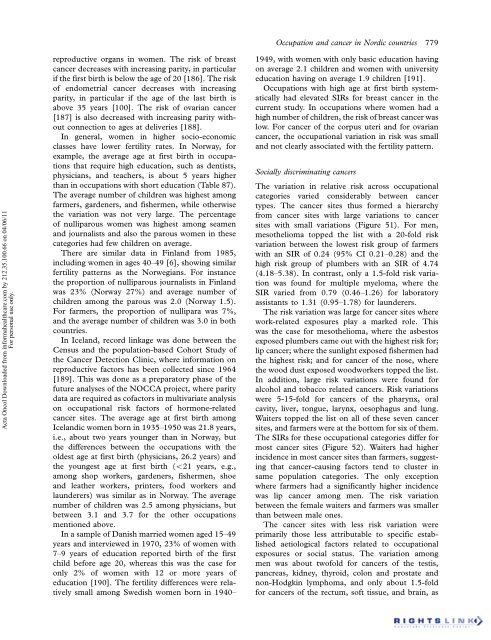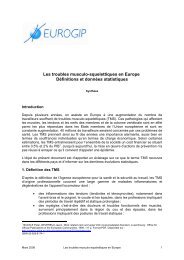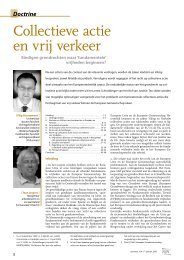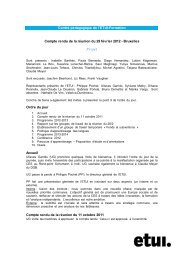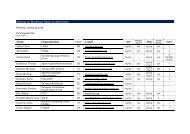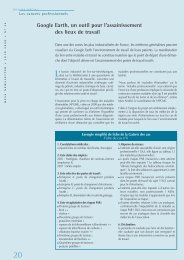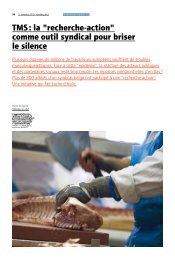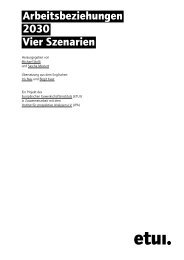Occupation and cancer - European Trade Union Institute (ETUI)
Occupation and cancer - European Trade Union Institute (ETUI)
Occupation and cancer - European Trade Union Institute (ETUI)
You also want an ePaper? Increase the reach of your titles
YUMPU automatically turns print PDFs into web optimized ePapers that Google loves.
Acta Oncol Downloaded from informahealthcare.com by 212.35.100.66 on 04/06/11<br />
For personal use only.<br />
reproductive organs in women. The risk of breast<br />
<strong>cancer</strong> decreases with increasing parity, in particular<br />
if the first birth is below the age of 20 [186]. The risk<br />
of endometrial <strong>cancer</strong> decreases with increasing<br />
parity, in particular if the age of the last birth is<br />
above 35 years [100]. The risk of ovarian <strong>cancer</strong><br />
[187] is also decreased with increasing parity without<br />
connection to ages at deliveries [188].<br />
In general, women in higher socio-economic<br />
classes have lower fertility rates. In Norway, for<br />
example, the average age at first birth in occupations<br />
that require high education, such as dentists,<br />
physicians, <strong>and</strong> teachers, is about 5 years higher<br />
than in occupations with short education (Table 87).<br />
The average number of children was highest among<br />
farmers, gardeners, <strong>and</strong> fishermen, while otherwise<br />
the variation was not very large. The percentage<br />
of nulliparous women was highest among seamen<br />
<strong>and</strong> journalists <strong>and</strong> also the parous women in these<br />
categories had few children on average.<br />
There are similar data in Finl<strong>and</strong> from 1985,<br />
including women in ages 40 49 [6], showing similar<br />
fertility patterns as the Norwegians. For instance<br />
the proportion of nulliparous journalists in Finl<strong>and</strong><br />
was 23% (Norway 27%) <strong>and</strong> average number of<br />
children among the parous was 2.0 (Norway 1.5).<br />
For farmers, the proportion of nullipara was 7%,<br />
<strong>and</strong> the average number of children was 3.0 in both<br />
countries.<br />
In Icel<strong>and</strong>, record linkage was done between the<br />
Census <strong>and</strong> the population-based Cohort Study of<br />
the Cancer Detection Clinic, where information on<br />
reproductive factors has been collected since 1964<br />
[189]. This was done as a preparatory phase of the<br />
future analyses of the NOCCA project, where parity<br />
data are required as cofactors in multivariate analysis<br />
on occupational risk factors of hormone-related<br />
<strong>cancer</strong> sites. The average age at first birth among<br />
Icel<strong>and</strong>ic women born in 1935 1950 was 21.8 years,<br />
i.e., about two years younger than in Norway, but<br />
the differences between the occupations with the<br />
oldest age at first birth (physicians, 26.2 years) <strong>and</strong><br />
the youngest age at first birth (B21 years, e.g.,<br />
among shop workers, gardeners, fishermen, shoe<br />
<strong>and</strong> leather workers, printers, food workers <strong>and</strong><br />
launderers) was similar as in Norway. The average<br />
number of children was 2.5 among physicians, but<br />
between 3.1 <strong>and</strong> 3.7 for the other occupations<br />
mentioned above.<br />
In a sample of Danish married women aged 15 49<br />
years <strong>and</strong> interviewed in 1970, 23% of women with<br />
7 9 years of education reported birth of the first<br />
child before age 20, whereas this was the case for<br />
only 2% of women with 12 or more years of<br />
education [190]. The fertility differences were relatively<br />
small among Swedish women born in 1940<br />
<strong>Occupation</strong> <strong>and</strong> <strong>cancer</strong> in Nordic countries 779<br />
1949, with women with only basic education having<br />
on average 2.1 children <strong>and</strong> women with university<br />
education having on average 1.9 children [191].<br />
<strong>Occupation</strong>s with high age at first birth systematically<br />
had elevated SIRs for breast <strong>cancer</strong> in the<br />
current study. In occupations where women had a<br />
high number of children, the risk of breast <strong>cancer</strong> was<br />
low. For <strong>cancer</strong> of the corpus uteri <strong>and</strong> for ovarian<br />
<strong>cancer</strong>, the occupational variation in risk was small<br />
<strong>and</strong> not clearly associated with the fertility pattern.<br />
Socially discriminating <strong>cancer</strong>s<br />
The variation in relative risk across occupational<br />
categories varied considerably between <strong>cancer</strong><br />
types. The <strong>cancer</strong> sites thus formed a hierarchy<br />
from <strong>cancer</strong> sites with large variations to <strong>cancer</strong><br />
sites with small variations (Figure 51). For men,<br />
mesothelioma topped the list with a 20-fold risk<br />
variation between the lowest risk group of farmers<br />
with an SIR of 0.24 (95% CI 0.21 0.28) <strong>and</strong> the<br />
high risk group of plumbers with an SIR of 4.74<br />
(4.18 5.38). In contrast, only a 1.5-fold risk variation<br />
was found for multiple myeloma, where the<br />
SIR varied from 0.79 (0.46 1.26) for laboratory<br />
assistants to 1.31 (0.95 1.78) for launderers.<br />
The risk variation was large for <strong>cancer</strong> sites where<br />
work-related exposures play a marked role. This<br />
was the case for mesothelioma, where the asbestos<br />
exposed plumbers came out with the highest risk for;<br />
lip <strong>cancer</strong>; where the sunlight exposed fishermen had<br />
the highest risk; <strong>and</strong> for <strong>cancer</strong> of the nose, where<br />
the wood dust exposed woodworkers topped the list.<br />
In addition, large risk variations were found for<br />
alcohol <strong>and</strong> tobacco related <strong>cancer</strong>s. Risk variations<br />
were 5-15-fold for <strong>cancer</strong>s of the pharynx, oral<br />
cavity, liver, tongue, larynx, oesophagus <strong>and</strong> lung.<br />
Waiters topped the list on all of these seven <strong>cancer</strong><br />
sites, <strong>and</strong> farmers were at the bottom for six of them.<br />
The SIRs for these occupational categories differ for<br />
most <strong>cancer</strong> sites (Figure 52). Waiters had higher<br />
incidence in most <strong>cancer</strong> sites than farmers, suggesting<br />
that <strong>cancer</strong>-causing factors tend to cluster in<br />
same population categories. The only exception<br />
where farmers had a significantly higher incidence<br />
was lip <strong>cancer</strong> among men. The risk variation<br />
between the female waiters <strong>and</strong> farmers was smaller<br />
than between male ones.<br />
The <strong>cancer</strong> sites with less risk variation were<br />
primarily those less attributable to specific established<br />
aetiological factors related to occupational<br />
exposures or social status. The variation among<br />
men was about twofold for <strong>cancer</strong>s of the testis,<br />
pancreas, kidney, thyroid, colon <strong>and</strong> prostate <strong>and</strong><br />
non-Hodgkin lymphoma, <strong>and</strong> only about 1.5-fold<br />
for <strong>cancer</strong>s of the rectum, soft tissue, <strong>and</strong> brain, as


